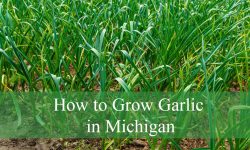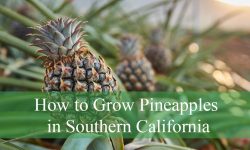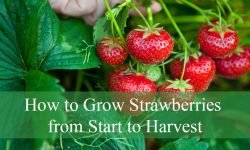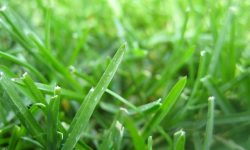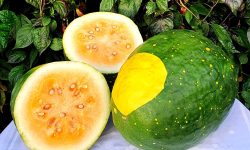California Native Grasses play a crucial role in maintaining the ecological balance of the region, contributing to the biodiversity of the state’s unique landscapes. These grasses, well adapted to California’s diverse ecosystems, include species such as California melic, Pacific reedgrass, Blue grama, Alkali sacaton, and many more.
The article below will provide information about 15 types of California Native Grasses with images and how to identify them.
Different types of California Native Grasses
Tufted hairgrass
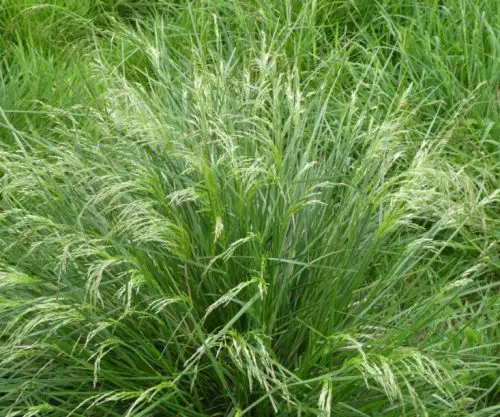
Tufted hairgrass, scientifically known as Deschampsia cespitosa, a cool-season perennial bunchgrass, thrives in arctic and temperate regions globally, making it one of the most widely distributed grasses.
In California, it flourishes in coastal prairies and mountain meadows, especially in wetland-riparian habitats. With dark green leaves and finely textured foliage, this ornamental grass reaches about 3 ft tall and wide in California.
Tufted hairgrass is semi-evergreen, adapting to various conditions, and boasts airy flower panicles in shades of green, purple, and gold. Valuable for restoration, revegetation, and as pasture grass, it enhances landscapes when massed together, creating a stunning display in transitional borders or wet meadows.
Tolerant of diverse soils, it prefers partial sun or shade and consistently moist to occasionally wet soil. Its versatility makes it an excellent choice for home landscapes, especially when combined with other grasses, perennial herbs, and annual wildflowers.
California melic
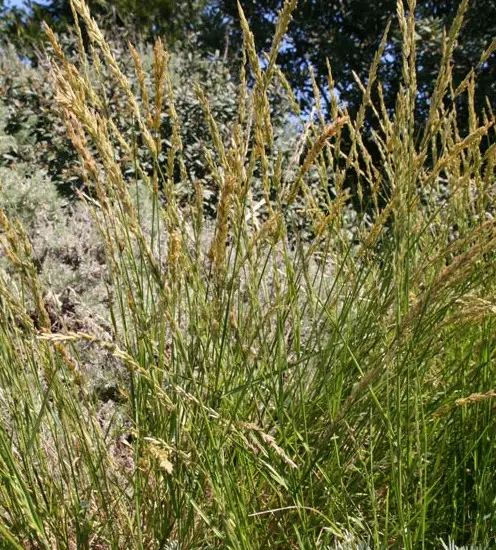
The cool-season perennial bunchgrass known as California melic (Melica californica) is unique to California and Oregon. It thrives in mountain forests, the Coast Ranges, the foothills of the Sierra Mountains, and open rocky slopes. This grass, native to various ecosystems like oak forests and coastal sage scrub, shines in water-wise gardening.
Deeply rooted and drought-tolerant, its slender, vivid green leaves grow to a height of 1-2 feet before attaining a golden-brown hue in the latter part of summer. The 2-4 foot tall, airy inflorescences, lovely even during dormancy, are ornamented with translucent bracts and purple-banded green spikelets.
California melic serves as a host plant for the rural skipper butterfly, thriving in partial shade and requiring little watering. It adapts to a variety of soil types and helps stabilize slopes and reduce erosion, making it perfect for rock and butterfly gardens or bulk planting.
Pacific reedgrass
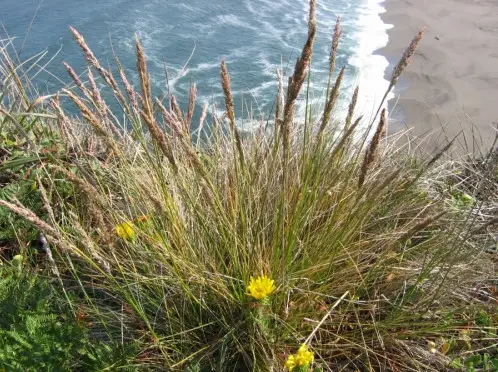
Calamagrostis nutkaensis, the official name for Pacific reedgrass, is a perennial bunchgrass that grows in cool climates and is native to western North America. This coastal species, which can be found in California’s damp woodlands, wetlands, dunes, and beaches, can be found from Alaska to San Luis Obispo.
It is common throughout the north and central coasts, where it grows in dense tufts of 3–4 feet tall, bold-green, rough-textured leaf that resemble regal fountains. Slender spikelets fade to gold in late summer, and flower panicles grow one to two feet above the mound in May.
It’s a plant that can withstand wind, sea spray, drought, and deer resistance, and it serves as a host plant for the Arctic skipper butterfly. It works well as a foundation plant, a backdrop of wildflowers, and for erosion prevention. It thrives in full sun to partial shade. It looks great in pots and makes a bold statement in gardens with butterflies or birds.
Blue grama
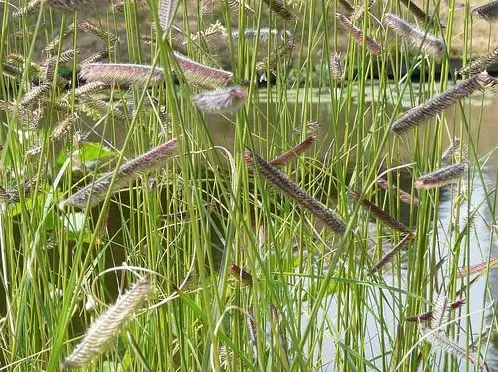
Known by its scientific name Bouteloua gracilis, or mosquito grass, blue grama is a warm-season perennial grass that is widely distributed throughout North America. It is especially well-established in the shortgrass prairies of the southern and central Great Plains. It is limited to dry mountainous areas in California, such as the Mojave National Preserve and the counties of San Bernardino and Riverside.
Blue grama is a plant that changes its growth pattern according to its environment. It grows to a modest height of 1-2 feet in the south and changes into a sod-former in the north or at higher elevations. Its elegantly shaped, finely textured leaves have a striking silvery-green color. Recently more well-liked, cultivars such as ‘Blonde Ambition’ add to its appeal.
Its unusually bent seed head, which resembles eyelashes or a slender pennant waving in the wind, is one of its most striking characteristics. The inflorescences begin as a light green, grow to purple, and then turn honeyed gold.
Many Lepidoptera species, such as the Ridings’ satyr (Neominois ridingsii) and the forest skipper (Ochlodes sylvanoides), use California’s blue grama as their larval host. It can be used to replace turf, either on its own or in combination with buffalo grass (Bouteloua dactyloides).
The drought-tolerant blue grama is a low-maintenance plant that looks great as an accent piece in gardens or in meadows filled with wildflowers. It is a flexible and beautiful addition to landscapes in California, growing well in almost any well-drained soil whether planted in either full sun or moderate shade.
Alkali sacaton
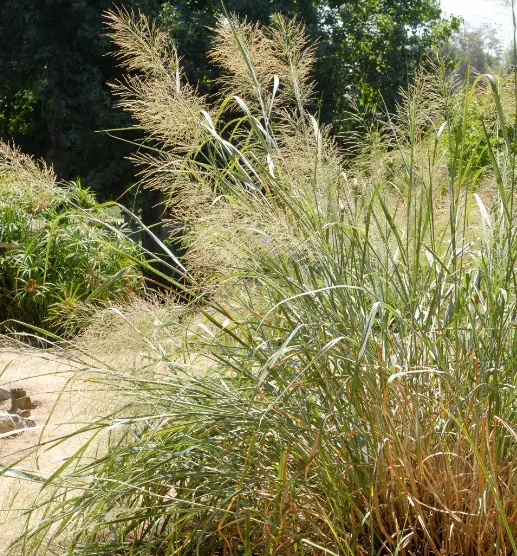
Strong-growing, warm-season perennial bunchgrass, Alkali sacaton (Sporobolus airoides) is indigenous to central and southern California. It grows well in coastal areas, foothills, and desert environments with groundwater basins. It is commonly found in playas, vernal ponds, alkali sinks, and locations with seeps or seasonal drainages. It has been used historically as a marker of freshwater availability.
This deciduous grass grows quickly and has a moderate lifespan, reaching a height of 3-5 feet and a width of 2 feet at its base. In the fall and winter, its slender, silvery-green leaves become a golden brown color. In midsummer, delicate yellow flower panicles bloom, producing an open, airy seed head with tiny scarlet spikelets that like a purplish pink mist above the foliage.
Alkali sacaton, whose name comes from the Nahuatl or Aztec word for grass, zacatl, is a vital fodder grass for wildlife and livestock in arid climates. Historically, Indigenous peoples valued the seeds of this plant as a food source.
Sporobolus airoides enhances the beauty of pocket prairies, wildflower meadows, and xeriscape gardens in home landscapes. It provides erosion control, looks good in mass plantings or as an accent, and its chopped flower culms make lovely arrangements. Sandhill skipper (Polites sabuleti) and wandering skipper (Panoquina errans) find refuge in Alkali sacaton, which is also a popular food source for songbirds and other pollinators. It grows well in a variety of soil types, so plant it in full sun.
Prairie Junegrass
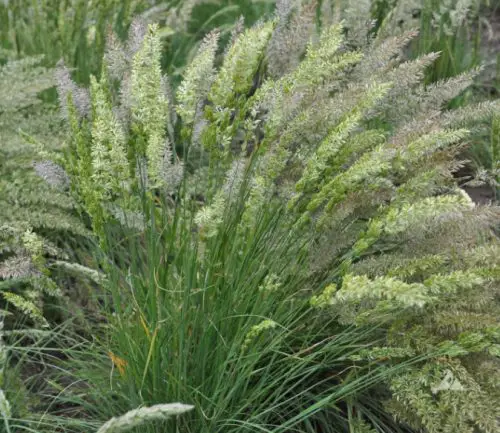
The prairie Junegrass, or Koeleria macrantha, is a neat perennial bunchgrass that grows throughout much of North America. Its range extends from Alaska to northern Mexico and the eastern United States. It grows well in many different types of habitats in California, although it is most common in chaparral, coastal sage scrub, and central oak woods, which are dry, open places. With the help of wind-assisted pollination, Junegrass, which grows 1-2 feet tall from a dense basal tuft of silvery blue-green leaves, produces flower panicles that change from heavy spikes with a pinkish-purple tinge to airy flaxen plumes that extend 12–18 inches above the foliage.
In addition to providing food for animals like deer, elk, and pronghorns, Junegrass is prized as a feed for cattle. It serves as a host plant for the butterflies Hesperia columbia and Nevada skipper (Hesperia nevada), and several birds and small mammals eat the seeds. Native Californians used the narrow leaves for scouring brushes, paintbrushes, and brooms, and powdered the seeds for flour.
Junegrass is a sun-loving plant that thrives in areas with well-drained, rocky or sandy soil, moderate wetness, and a variety of loams in light shade. It is less successful in deep shadow or wet, heavy clay soils. Because of its small size and resistance to fire, it is a great option for gardens due to its drought tolerance. Plant it under native oak trees, in wildflower meadows, pollinator or rock gardens, pocket prairies, or with colorful perennials that mask its summer hibernation. On occasion, golf course roughs will use it as turfgrass.
California oatgrass
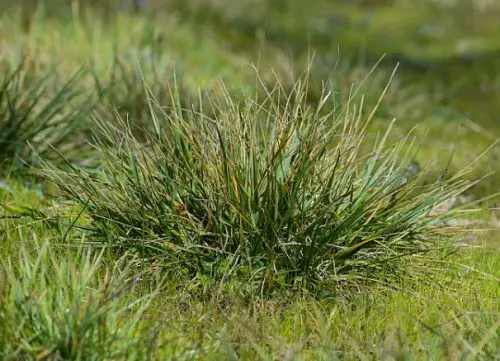
The tiny cool-season perennial bunchgrass known as California oatgrass (Danthonia californica) is native to North America and can be found from British Columbia to southern California, as well as to Saskatchewan, Montana, the Rocky Mountains, New Mexico, and Arizona in the east. Found mostly in the states along the Pacific Coast, it grows well in the Coast Ranges and Sierra Nevada of California, especially in wet meadows and open areas that are frequently accompanied by closed-cone pine forests and coastal sage scrub.
California oatgrass is a semi-evergreen plant with velvety, blue-green leaves that grow up to three feet tall. In the heat of the late summer, the leaves somewhat brown, but they eventually turn green again when it rains in the fall. Its little flower spikelets are open and loosely grouped, and they frequently have a purple tinge. In California’s rare and threatened ecosystems, this grass is essential, especially in the last coastal terrace prairies that are home to federally endangered species like the Ohlone tiger beetle. It works well for revegetation, wildlife plantings, and restoration projects.
California oatgrass is a great option for replacing a lawn, withstanding frequent mowing, high traffic, and mild summer moisture stress. It also adds biodiversity to home landscapes. It functions well as a firebreak and erosion control grass, providing cattle and wildlife with nutrient-rich fodder. Use it as a focal point in pollinator, bird, or rock gardens, or in meadows; it looks great around pavers and stones. It can withstand flooding and grows well in clay or loamy soils in either full sun or moderate shade. California oatgrass adds to the ecological richness of landscapes by acting as a larval host for a number of Lepidoptera species, such as Lindsey’s skipper (Hesperia lindseyi) and Columbian skipper (Hesperia columbia).
Deergrass
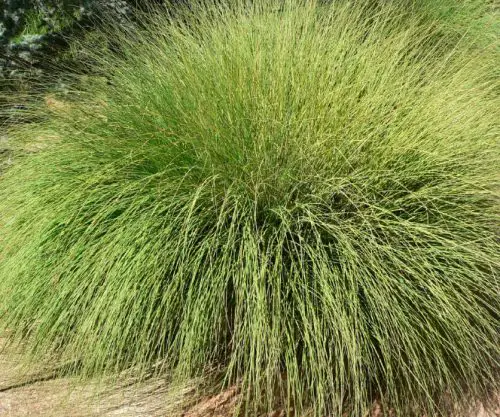
Muhlenbergia rigens, the scientific name for deergrass, is a perennial bunchgrass that grows warm seasons and is indigenous to the southwestern United States and some regions of Mexico. It can be found growing in a variety of environments in California, including valley grasslands, yellow pine forests, mixed oak woodlands, and wetland-riparian communities. It is most abundant in the state’s coast ranges, Sierra Mountains, and Cascade foothills. This grass grows into a dense, fountain-like base tuft that is 4-6 feet wide and rises to a height of 3 feet. It has whip-like flower stalks that arch out and produce plumes that rise 2 feet above the mound, giving it the appearance of a spectacular fireworks display. With evergreen foliage, the leaves are small, pointed, and have a light silvery-green to purple coloration.
Deergrass, so named because mule deer like to lie down in its drifts during the fawning season, is surprisingly thought to be deer-resistant. Birds are drawn to its seeds, while deer, cattle, and horses may graze on the younger, more edible individuals. This species enhances the biodiversity of the area by acting as a host plant for the umber skipper and the California ringlet butterfly.
Native Californians make coiled baskets out of deergrass culms; thousands are needed to construct one. Deergrass is a common nursery plant that is frequently grown for its easy-to-maintain growth habit and ornamental appeal. Deergrass is great in pots and makes a great addition to walks, bird or pollinator gardens, and massed drifts. It grows quickly, maturing in 1-2 years in either full sun or partial shade. It can grow in complete shade, but it might do so more slowly. Although it may grow in a variety of soil conditions, including clay, deergrass thrives on sandy or gravelly loams and needs little to no irrigation.
California fescue
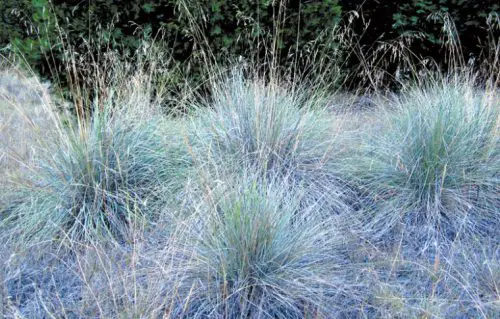
The cool-season perennial bunchgrass known as California fescue (Festuca californica) is indigenous to the coast ranges, foothills, and valleys of California and Oregon, spanning from Clackamas County, OR, to San Luis Obispo. This semi-evergreen grass, which grows mostly in chaparral, mixed evergreen forests, and yellow pine forests, has a wide range of colors, from silvery blue to pale green. There are many different aesthetic options available from well-known cultivars like “Serpentine Blue,” “River House Blues,” “Phil’s Silver,” “Scott Mountain,” and “Horse Mountain Green.”
From March to July, California fescue, which grows in mid-sized, fountain-like tufts that are 2-3 feet high and 1-2 feet wide, produces flower panicles that rise 1-3 feet above the foliage. As a host for at least nine Lepidoptera species, it is one of the native Poaceae (grasses) of the North Coast and has great wildlife significance. For ground-nesting birds such as California quail, wild turkeys, spotted towhees, and dark-eyed juncos, mature plants provide essential cover. Rodents find shelter in the thick grass mounds, and in the winter, burrows are used by reptiles such as ring-necked snakes and alligator lizards. Foxes and coyotes are among the predators that frequently hunt in these locations.
California fescue is very desirable to birds, rodents, and harvester ants due to its ecological significance. Its extensive roots make it useful for erosion control and restoration plantings in addition to supporting wildlife. Cultivated for decorative purposes, this low-maintenance grass shows resilience to dryness and hardiness at an early age. It’s becoming more and more common on southern California golf courses, taking the place of the fussy tall fescue (F. arundinacea), which makes a great fairway combination with coast live oaks.
California fescue adds winter interest to beds and borders in gardens by acting as a neat specimen plant or groundcover. It can survive in clay and serpentine soils, but it really likes full sun or dappled shade, especially under native deciduous oaks. Think of enhancing it with fine turfgrass like red fescue (F. rubra) and nutrient-rich fodder grass like Idaho fescue (F. idahoensis) that can be used by both domestic and wild animals.
Clustered field sedge
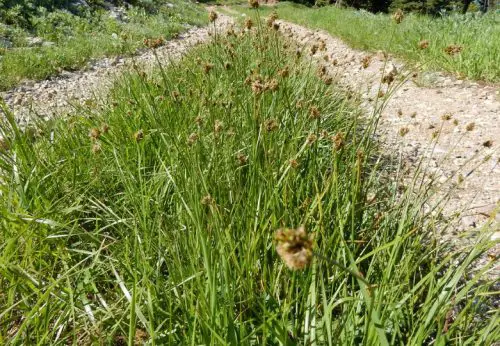
The Cyperaceae family includes clustered field sedge (Carex praegracilis), often referred to as western meadow sedge. Although it is not strictly a grass, it does adhere to the saying that “sedges have edges, rushes are round, and grasses have knees that bend to the ground.” Native to much of North America, this cool-season, sod-forming sedge ranges from Alaska through southern Canada and throughout the United States (south of the Southeast). It grows well in open, moist, or occasionally wet environments in California, like marshes and meadows. It is typically found in riparian or semi-riparian environments in dry climates.
Carex praegracilis is a plant community contributor to red fir or yellow pine forests, valley grasslands, mountain meadows, coastal strands, coastal sage scrub, and creosote bush scrub. This sedge, which is frequently found by roadsides and disturbed areas, has sharply triangular, silver to rich green stems that grow to a height of two to three feet from rhizomes. Pale green flower spikelets turn golden brown, and tiny fruits called achenes are encased in bracts that resemble sacs. The leaf demonstrates versatility; it can be either evergreen or summer deciduous when stressed by dryness.
At least ten Lepidoptera species use C. praegracilis as their larval host, and it’s widely used in California as a natural alternative to lawns. When left alone, it keeps its lush, unkempt appearance, but once established, it can tolerate being mowed to a height of 4 to 6 inches and light foot traffic. It is estimated that installing clustered field sedge in place of typical turfgrass will save homeowners’ water bills by two thirds while preserving the year-round green appearance of the lawn. It also works well for firebreaks, bioswales, and erosion management.
Clustered field sedge looks great in containers and is perfect for wildflower meadows, paving stone settings, and mingling with perennials. Plant it in full sun on a variety of soil types; if the site isn’t getting enough moisture, water it once a week. With more than 150 identified kinds, native Carex species are abundant in California. Santa Barbara sedge (Carex barbarae) and foothill sedge (Carex tumulicola) are two other suggested choices for home landscapes.
Purple three-awn
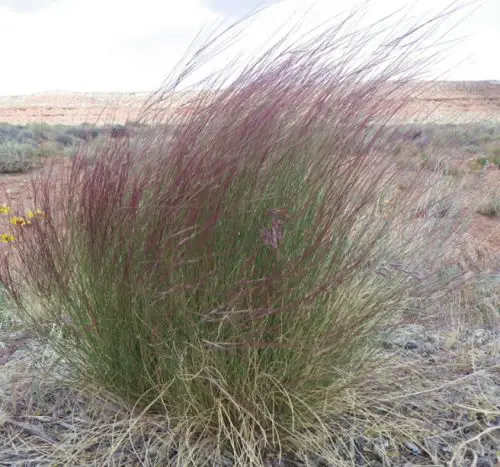
Aristida purpurea, often known as purple three-awn, is a perennial bunchgrass that grows during the warm season in the Great Plains states, spanning from southern Canada to northern Mexico. It grows well in a variety of settings in California, including coastal, desert, and mountainous areas from Mono County south to Baja. Plant groups such as Joshua tree forests, coastal sage scrub, and creosote bush scrub are characterized by its presence. It has an upright growth habit and can grow up to 3 feet tall and 2 feet broad. It has multiple variations, all of which have geographical ranges that overlap.
Because of its spiky spikelets, A. purpurea is typically thought to be inedible to grazing animals, yet it can be grazed before seed heads form. Its thorny seeds stick to cloth and fur easily, so plant it away from places where kids and dogs visit. Notable for being a host plant for the white-lined sphinx moth (Hyles lineata), it also supplies food for juncos and other songbirds, and small game animals use its foliage as a cover and a place to build nests.
With its beautiful plum-colored blossoms and finely textured leaves, this grass is a joy for lovers of grass. Warm breezes provide a captivating smokey purple haze in the summer and fall, which gives residential landscapes an amazing touch. Purple three-awn is adaptable and works well in containers, whether it’s massed behind garden sculpture, along walkways, or in beds and borders. A. purpurea is easy to care for, very drought-tolerant, and soil-tolerant. It grows best in sunny, dry areas that receive little irrigation. Its fibrous root system provides a loose substrate that supports the growth of wildflowers and is an effective erosion control mechanism.
Giant wildrye
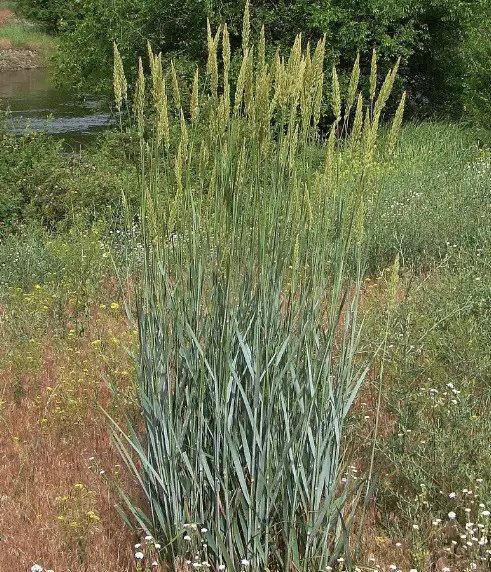
Known by several other names, gigantic rye grass (Elymus condensatus) is a perennial bunchgrass that is endemic to California and Baja. It is remarkably huge and resilient. It is generally restricted to the southern portion of the state and its coastal regions. It is found in clearings and the boundaries of habitats; it is frequently found in coastal sage scrub, chaparral, oak woods, Joshua tree woodlands, and riparian corridors. Giant wildrye is the tallest of our native grasses; it typically reaches maturity of 3 to 6 feet, but it can reach heights of 11 feet. Its base is between two and eight feet wide, and it progressively expands by rhizomes.
With its unique, year-round silvery-blue leaves, Elymus condensatus lends an air of refinement to home settings. As an accent plant or grand specimen, it adds enduring charm and character. Its powder-blue flowers and seed heads turn into a spectacular feature in the summer and add a light touch to floral arrangements. In addition to being aesthetically pleasing, gigantic wildrye is a great forage plant that draws grazers, while birds and small mammals eat the seeds. Notably, it serves as a larval host for up to 13 different species of Lepidoptera.
Native Americans in California discovered many applications for this plant, using its reeds to make straw drinking glasses, roof thatching, and lightweight arrow mainshafts. The Chumash people used the secretions of aphids to extract sweets, the leaves to beat animal hides, and the sugars to roll into balls.
Although it can withstand dryness, giant wildrye should not be overwatered as this could lead to it losing its shape. It grows best in full sun and is adaptable to a variety of soil types, including sand, clay, and serpentine. Selected from San Miguel Island, the ‘Canyon Prince’ cultivar has a more compact growth habit. In addition, for your landscape requirements, think about using blue wildrye (Elymus glaucus).
Purple needlegrass
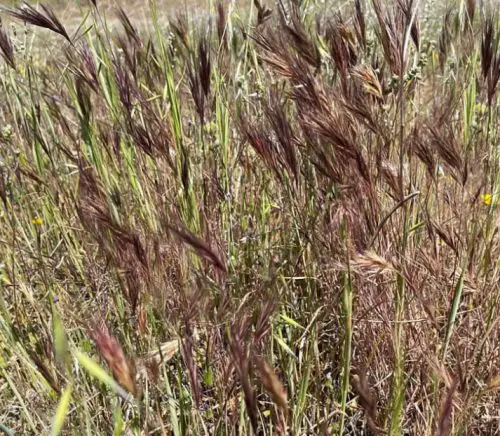
Stipa pulchra, or purple needlegrass, is a hardy, upright perennial bunchgrass indigenous to California that stretches from the Oregon border to Baja. After dominating California’s vast grasslands for a while, it has come to represent legacy and the richness of unspoiled environments in the past. A staple diet for Native Californians, who ground its seeds into pinole, this grass is recognized as the official state grass and can live over 200 years.
Its purple-tinted seed awns and finely textured leaves gave the hillsides a shimmering gold and silver-green hue during its peak years. With over 330 terrestrial lifeforms supported by its deep roots and longevity, it is an essential source of feed for wildlife such as elk and deer.
It also fosters delicate ecological connections. Purple needlegrass is an adaptable addition to residential landscaping since it thrives in a variety of soil types and is quite drought-tolerant. It adds a bit of history and resiliency, whether it is combined with native oaks and shrubs for a rustic look, or with other grasses and wildflowers for elegance. It spreads freely and grows to be 3 feet tall and 2 feet broad. Its distinctive bristle-like awn resembles a needle and thread.
People Who Read This Also Read:

